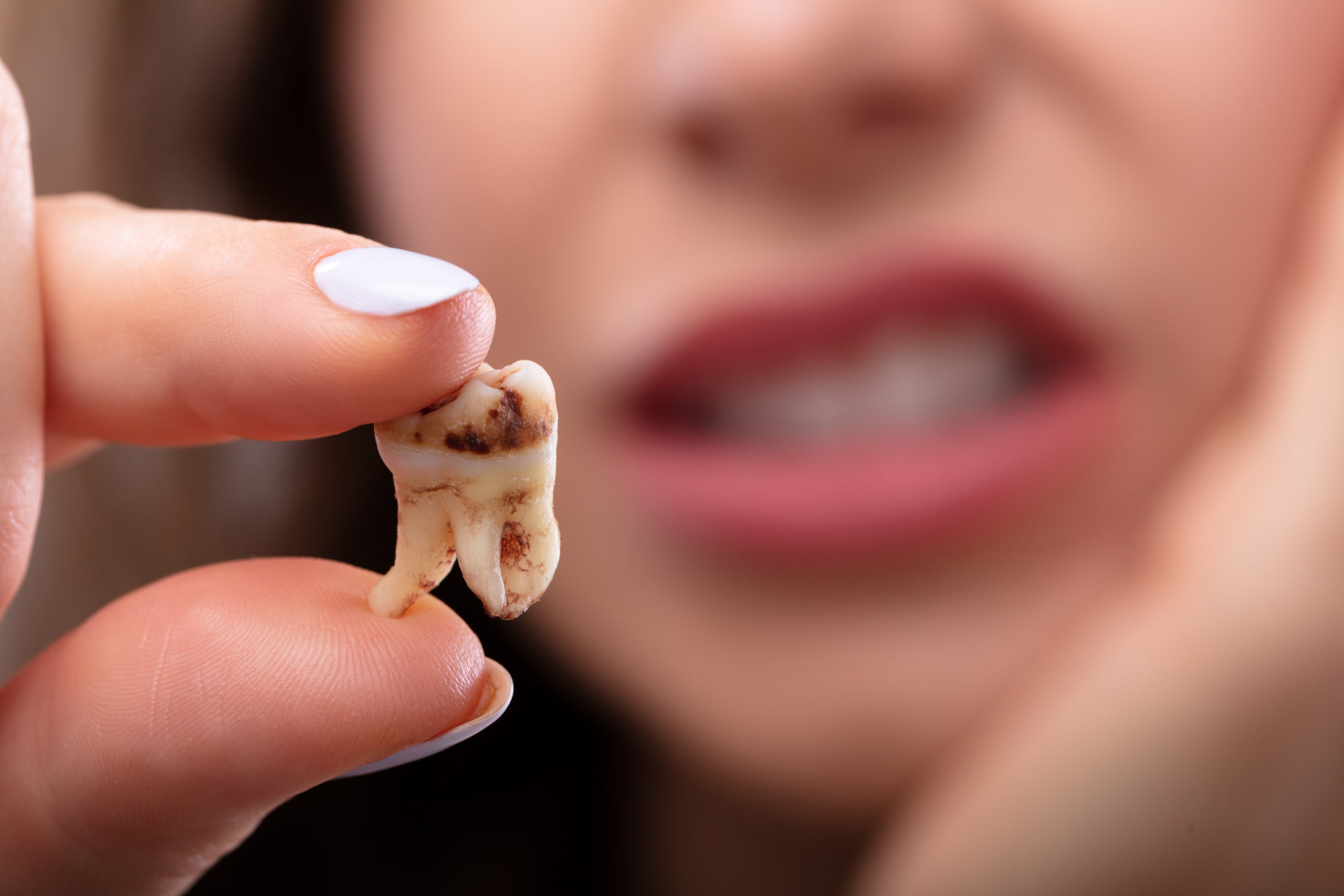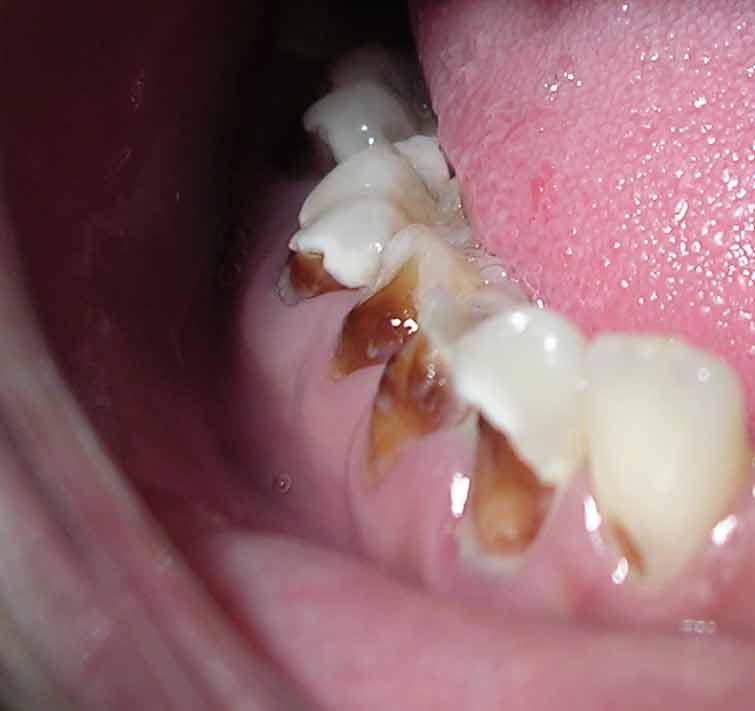A tooth is a hard and resistant organ that allows you to bite and grind food. The visible part of a healthy tooth is generally composed of a hard, white crown (enamel) and one or many roots implanted in the alveolar bone of your jaw. In addition to cutting and grinding food, teeth have an aesthetic role to play; they embellish your smile. Unfortunately, your teeth may become decayed and change color, this medical condition is called dental cavity (also known as dental caries or tooth decay).
Cavity is an irreversible alteration of the enamel and ivory of your tooth which gradually evolving the destruction of all other organs of the tooth. En general, cavity develops in 4 phases:
Phase 1 – during the first stage, the cavity is only in the enamel. The cavity is painless, because the enamel has no nerves. If you observe your teeth closely, you can detect the decay, but it is often unnoticed. The best way to detect the probem and treat it is visiting your dentist. That’s why it is important to see your dentist every 6 months.
Phase 2 – In phase 2, the tooth becomes sensitive to hot and cold. In addition, the tooth may have a little discoloration. You will likely discover the decay. Your dentist can remove the decayed tissue and fill the gap with either an amalgam or an appropriate restorative material.
Phase 3 – the third phase is characterized by a painful attack of the caries in the pulp, the soft tissue forming the inner part of your teeth and containing nerves and blood vessels. In phase 3, the cavity can not only cause pain, but also becomes more difficult to be repaired.
Phase 4 – phase 4 is the last stage of the cavity; the decay destroys the tooth pulp and cause severe pain. The infection can spread outside the tooth and causes inflammation of your gums (gingivitis). The decay requires medical attention to prevent severe pain, tooth loss or a rare form of infection called sepsis.
Tooth Decay Causes
Several factors may contribute to the development of tooth decay, some of them include:
 Poor oral hygiene – a lack of dental hygiene may be the main factor in the formation of tooth decay. Your teeth are covered with a film of mucus and bacteria called bacterial plaque. Those microorganisms come from either food or other sources. To prevent them from attacking and destroy your teeth, regular brushing and flossing habit is essential.
Poor oral hygiene – a lack of dental hygiene may be the main factor in the formation of tooth decay. Your teeth are covered with a film of mucus and bacteria called bacterial plaque. Those microorganisms come from either food or other sources. To prevent them from attacking and destroy your teeth, regular brushing and flossing habit is essential.
Tobacco smoke – Smoking tobacco, including children exposed to passive smoking of parents, reduces salivation, weakens the immune system and promotes the growth of bacteria in your mouth. In fact, smoking not only increases the chance of tooth decay but also a variety of cancers.
Sugar Consumption – Excessive consumption of sugars can suppress your immune system, favor acidity (in your mouth) and formation of cavities. Therefore, it is important that you:
- Reduce consumption of sweet foods such as candy, desserts (cake for instance), soft drinks, etc.
- Floss and Brush your teeth after every meal, especially after eating sweet or sticky foods.
- Chewing – avoid sucrose chewing gum; chewing them too often can be harmful to your teeth. Consider use chewing gum sweetened with 100% xylitol; they help stimulate production of saliva and increase oxygen in your mouth
- Avoid frequent snacking – although it said that frequent snacking can help your metabolism and promote weight loss (controversial), having
nutrients in your mouth frequently cause bacteria to be more active thus facilitating formation of tooth decay.
Cancer treatment – Cancer treatment such as radiotherapy and chemotherapy can lead to a salivary hyposecretion (dry mouth). Saliva provides oxygen to your mouth and prevents overgrowth of bacteria and formation of tooth decay. Radiation therapy and most chemotherapy drugs destroy your salivary glands and the amount of oxygen in your mouth, putting you at higher risk of cavity. Treatment with corticosteroids may also be responsible for tooth decay.
Diseases – certain diseases such as diabetes mellitus, hyperthyroidism, hyperparathyroidism, and stress are causative agents of dental caries.
Tooth Decay Warning Signs and Symptoms
Provided that the cavity remains in your email, you will not feel any pain. The first painful symptom start appearing once the decay has reached the dentine or the dental pulp. If you experience any of these symptoms below, it is important that you see your dentist to repair the tooth (teeth) before it is too late. Common symptoms of tooth decay include:
- Persistent toothache
- Feeling of pain when you bite
- Tooth sensitivity to hot and cold
- Tooth abscess
- Tooth sensitivity to sweet
- Red, tender or swollen gums
- Holes or pits in your teeth
- Dark brown or black stain in your tooth (teeth).
In general, if you notice a hole in your tooth, the decay is advanced; your need to see your dentist is necessary. In addition, if you have loose teeth, have bad taste, unreasonable bad breath, persistent gum bleeding, you should see your dentist as soon as possible. These symptoms are precursors of other serious medical conditions.
Diagnosis
In examining your mouth with an appropriate instrument, your dentist can easily diagnose your cavities. In addition, he / she will ask you questions about pain and tooth sensitivity you may feel. In early cavities, your dentist may recommend an X-ray to determine the extent of the cavity.
Tooth Decay Treatment
 At phases 1 and 2 of the cavity, your dentist will treat the tooth without affecting the pulp. She / he will remove the decayed part of your tooth, and fill the gap with tooth-colored composite resins or porcelain. Depending on the extension of the cavity, the anatomical repair can be made with a mercury amalgam (fillings), a colored material used to fill teeth that have cavities. However, choosing resin composites to restore your teeth is safer. Although controversial, dental amalgam can cause the following medical conditions:
At phases 1 and 2 of the cavity, your dentist will treat the tooth without affecting the pulp. She / he will remove the decayed part of your tooth, and fill the gap with tooth-colored composite resins or porcelain. Depending on the extension of the cavity, the anatomical repair can be made with a mercury amalgam (fillings), a colored material used to fill teeth that have cavities. However, choosing resin composites to restore your teeth is safer. Although controversial, dental amalgam can cause the following medical conditions:
- Gastrointestinal Problems
- Bleeding gums
- Sleep disturbances
- Concentration problems
- Memory disturbances
- Restlessness
- Damage to Brain in children and fetuses
In phase 3, Root canal or surgical removal of the entire coronal pulp (pulpotomy) can be performed to stop the pain and save the tooth. If the tooth is so infected that the tissue is necrotic, extraction of the dental pulp and root canal (pulpectomy) is often the only effective method to stop the pain. Pulpectomy is usually preceded by a local anesthetic
In phase4, the treatment is to disinfect the root canals with antiseptics and antibiotics prior to a root canal obturation, a procedure used to fill and seal your root canal. In severe cases, however, Tooth extraction is the only method that can be effective. Tooth extraction can cause your other teeth to move, your Surgeon-dentist can consider a dental implant to prevent this to happen.
Dental Cavity Prevention
When it comes to cavity, prevention is the best option. These preventive measures can help you keep your teeth healthy:
- Floss your teeth every day
- Avoid snacking between meals
- Visit your dentist regularly or every six months
- Chew sugar-free chewing gum
- Avoid processed foods and foods containing sugar
- Brush your teeth twice a day (morning and before going to bed) or after meals is important to prevent tooth decay. It is advised to use a soft toothbrush, not aggressive, and fluoridated toothpaste
Soft drinks, syrups and fruit juices are highly cariogenic (can produce or promote tooth decay); they decrease your oral pH, and increase your risk of cavity. Therefore, brush your teeth right away after eating them.



